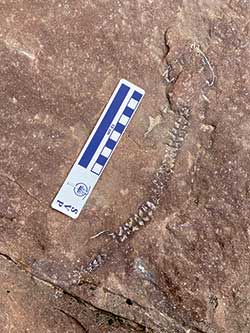 |
| There is still much to learn about ancient life from newly discovered fossils. This fossil of an early reptile relative was collected by paleontologists in Canyonlands National Park last year. The NPS plans to do a high power CT scan to learn more about it since the bones are too soft and the rock is too hard to do traditional fossil preparation with manual tools. Photo courtesy of Adam Marsh, National Park Service. |
One of the great things about living in or visiting a place like Moab is the surrounding public land. Public lands belong to all Americans, but locals and tourists alike in southeastern Utah benefit from the multitude of opportunities here to hike, mountain bike, jeep, and explore. Canyon country contains an abundance of natural wonders ranging from natural arches and rock spires to lush cottonwood groves along desert washes and to deep canyon carved by the mighty Colorado River. It is home to endemic fish species found nowhere else, and artifacts and rock art that help tell the story of at least 10,000 years of human habitation and use. And last (but certainly not least), the area’s rock layers (formations to geologists) contain a rich array of fossils that play an important role in documenting the history of life on the planet.
Fossils are the remains (or evidence) of living organisms from the geologic past preserved within a geologic context. (An easy-to-remember definition spells out FOSSIL: Fantastically Old Stone-like Specimen Indicating Life.) Alternatively, fossils are known as paleontological resources since the science of the history of life is known as paleontology.
Moab’s fossil record is exemplary. It is probably best known for its dinosaurs. Both important bone beds and track sites have been found on public land near Moab. Dinosaur fossils are present in several rock layers, but mostly in the Morrison Formation (deposited between 150 and 157 million during the Jurassic Period) and the Cedar Mountain Formation (between 100 and 140 million years; Cretaceous).
Beyond dinosaurs, fossils found in southeastern Utah include petrified wood and other plant fossils, other vertebrates like phytosaurs (a group of vertebrates that look crocodilian) and plesiosaurs and mosasaurs (dominant predators of the Cretaceous seas), and a wide range of invertebrate fossils, including crinoids, ammonites, oysters, and bivalves. Fossils found in the area range in age from more than 300 million years old to Pleistocene (Ige Age) fossils preserved in dry caves in Glen Canyon National Recreation Area.
Because of their scientific importance and because they are nonrenewal resources that are part of our geoheritage, the agencies responsible for managing public lands have long used policies to protect and manage fossils. But it wasn’t until 2009 and the passage of the Paleontological Resources Preservation Act (PRPA) that there was a specific law that mandated protection of fossils on public lands.
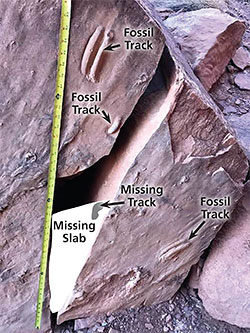 |
| Important scientific specimens like this fossil track site in Capitol Reef National Park are subject to theft or vandalism. The missing slab was stolen from the park sometime between 2017 and 2018. NPS photo with annotations by Allyson Mathis. |
ReBecca Hunt-Foster, Paleontologist at Dinosaur National Monument, explained what the PRPA does, “It gives clear direction to manage paleontological resources using scientific principles and expertise. It also requires that agencies maintain inventory and monitoring programs and establish educational programs. It clarifies the permitting procedures and requires that fossils are preserved in approved museums.”
Vincent Santucci, Senior Paleontologist for the National Park Service, added, “PRPA can be considered a companion law equivalent to the Archaeological Resources Protection Act (ARPA) enacted in 1979 which serves as a similar authority for archaeological resources.”
One of the things that the PRPA specifies is that land management agencies are required to develop specific rules (regulations) to implement the law. The Department of Agriculture published regulations for US Forest Service lands in 2015. The Department of Interior regulations became effective on September 1 of this year.
Santucci elaborated, “The development of regulations is an important step to assimilate the PRPA into each agency’s specific missions. There are important differences that only apply to some bureaus. The most important involves ‘casual collecting’ which is something that the Bureau of Land Management (BLM) and the Bureau of Reclamation allow, while the US Fish and Wildlife Service and the National Park Service (NPS) are explicitly exempt from casual collecting given their very different stewardship missions.”
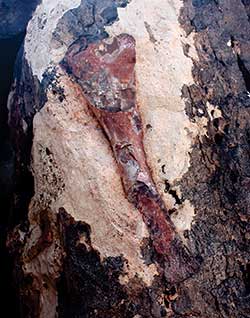 |
A dinosaur bone in the Morrison Formation near
Green River. |
Casual collecting of common invertebrate fossils like crinoids and bivalves and of petrified wood is allowable on BLM land. But vertebrate and other fossils are specifically protected. Lee Shenton, President of the Gastonia (Moab) Chapter of the Utah Friends of Paleontology, explained why this is important, “Amateur fossil collecting of vertebrate specimens or footprints can destroy significant scientific information. Please let the permitted experts and institutions do the right thing with proper and proven techniques.”
Santucci also said that one of the benefits of the new law is that it has increased awareness in national park staff and has fostered greater stewardship for fossils preserved in parks across the United States. Santucci has led an active fossil inventory strategy that has identified 283 national park sites that contain fossils. The NPS is also implementing a program to train park staff about the new laws and what it means for park operations.
One of the ways to think about a law is that they codify the values of our society. From this perspective, the PRPA can be viewed as an expression of the value that we collectively have for the fossils located on public lands and that belong to the American people. The new regulations implementing the PRPA will help ensure their protection and preservation.
To learn more, visit www.nps.gov/subjects/fossils.
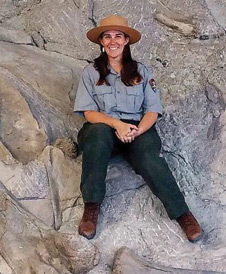 |
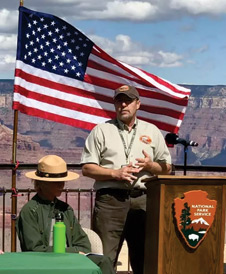 |
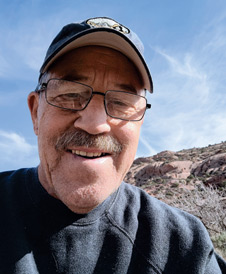 |
| ReBecca Hunt-Foster |
Vince Santucci |
Lee Shenton |
|